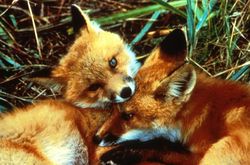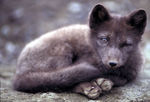
| True fox |
|---|
 |
| Scientific Classification |
| Genera and Species |
| Ruppel's Fox (Vulpes rueppellii) |
Foxes are species of canines belonging to the several taxonomic genera (Lycalopex, Dusicyon, Cerdocyonina, Urocyon, and Vulpes). However to be classified as a "true fox", the creature must be in the genus Vulpes. True foxes are smaller than other canines (like the wolves, coyotes, etc.), weighing between 11 and 24 pounds (5-11 kilograms), and have a flatter skull.[2] According to these qualifications, only the twelve species found in the genus vulpes are classified as true foxes.
Some better known examples of the species found in the genus Vulpes are the arctic fox, the red fox, and the cape fox. Members of the genus Vulpes are found in a variety of regions, such as the arctic, Asia, India, Africa, and North America. They tend to live in small family packs, but certain species such as the arctic fox prefer living alone. Foxes are omnivores and predators. Their bone structure is perfect for grasping their prey. The typical life span for these mammals is two to four years, but some have been known to live for up to a decade. [3]

As aforementioned, Members of the genus Vulpes have flatter skulls then other members of the family Canidae and also tend to be smaller in size.[1] Their weight ranges from 11 to 24 pounds (5-11 kg). They are known for their triangular faces and black whiskers, or vibrissae. Their ears are known to be pointed and their snouts are typically narrow. True foxes have bushy tails, or brushes. This distinguishable tail matches the coat which covers the fox, but the very tip of this tail is colored differently, often white or black. Between their eyes are unique black markings in a triangular shape. [4]
Their fur tends to be long, and range from such colors as red, white, black, or grey. Their fur can also change depending on the season, often denser in cold weather and lighter in warm weather. The color of their fur may change with age. As true foxes are found in varied regions, their characteristics vary from species to species, as God has equipped them with specific characteristics needed for their habitat. [5]
True foxes reproduce sexually, meaning "a mode of reproduction involving the fusion of female gamete (ovum) and male gamete (spermatozoon), which forms a zygote that potentially develops into genetically distinct offspring." [6] Mating season occurs in winter for foxes. A female fox is pregnant for roughly 53 days, during which she searches for a safe place to give birth to her cubs.
In early spring, her litter of 4-5 cubs are born deaf, blind, and helpless. The male fox has God-given instincts for catching food for his partner and offspring, as the female cannot leave her children in their early days. Over the course of the year,the mother has been gradually separating from her young and by August her cubs are fully grown and adult. Although foxes generally stay together, by this time the offspring are able to fend for themselves and they fight amongst themselves, typically resulting in a few offspring separating from the family. [7]

Foxes are omnivorous, and as such enjoy a variety of different foods. They are predators, feasting on smaller animals, such as rodents and certain reptiles or birds. They catch their prey by pouncing; they crouch down in such a way that they are effectively camouflaged, and then leap upon their prey. However, they also enjoy grazing on grasses and other such plants. They typically eat about 2 pounds a day and tend to hoard extra food. [8] The fox is prey himself to larger carnivores such as bears or wolves. Man also poses a major threat to foxes, hunting hunt these small canines for their coats or for sport. Foxes, when feeling threatened, rely on their speed to escape, rather than hiding in a den. [9]
Foxes are found in many different environments, ranging from desert to alpine tundra. Each species has been gifted by God to survive in their respective habitat. The arctic fox, for instance, has short legs, ears, and muzzle in order to minimize heat loss in the cold climate of the tundra. His dense fur insulates him effectively. [10] Predators of the arctic fox are such as polar bears, wolves, or even the snowy owl, which poses a threat only to fox cubs. [11]
Some species of fox live near people, most notably the red fox. They are attracted to the copious amounts of edible trash found in suburban areas, reminiscent of raccoons. Unfortunately, the modern world poses many risks for these small creatures, such as cars. Some people attempt adopting foxes as pets, drawn by their resemblance to the common household dog. Some are successful in this endeavor, but the fox typically does not pair well with domestic life. They pose no threat to humans, however, being more skittish than dangerous. [12] Domesticating the silver fox has been experimented with in Russia, with success at some degree. [13]
Fox hunting has been a popular sport ever since the sixteenth century, originating in England and spreading to countries such as Australia, Italy, and the United States. The practice was banned in England and Wales in 2005 and in Scotland in 2002, although some forms of hunting them remain legal such as shooting the canines as pests. [14] Foxes are also hunted for their fur rather than for the thrill of the chase. The red fox as well as the arctic fox have fur that is highly valued in many regions of the world. Some people raise foxes on 'fur farms'. [15]
This video is a demonstration of how a fox tends to hunt in the arctic.
Arctic Fox
(Vulpes lagopus)
Red Fox
(Vulpes vulpes)
Ruppel's Fox
(Vulpes rueppellii)
|
||||||||||||||||||||